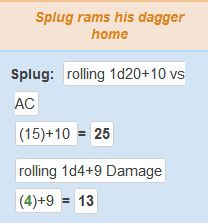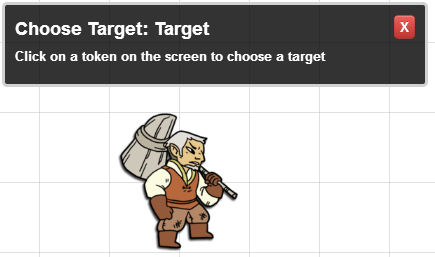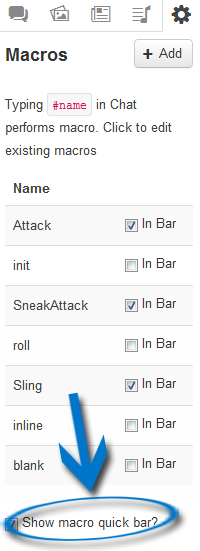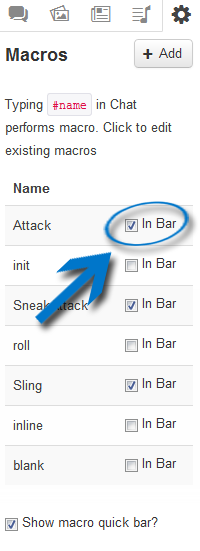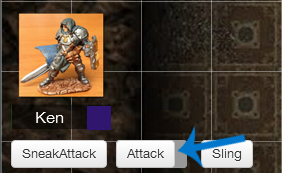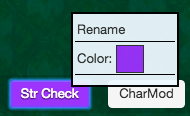Difference between revisions of "Macros"
From Roll20 Wiki
m (Reverted edits by 1048758 (talk) to last revision by Juniper L.) |
(→Example) |
||
| Line 31: | Line 31: | ||
One of the strengths of the macro system is its ability to execute multiple actions with a single command. To do this, simply put each item on its own line, and they will be executed in order when you run the macro. | One of the strengths of the macro system is its ability to execute multiple actions with a single command. To do this, simply put each item on its own line, and they will be executed in order when you run the macro. | ||
| + | <gallery> | ||
| + | File:Example.jpg|Caption1 | ||
| + | File:Example.jpg|Caption2 | ||
| + | </gallery> | ||
=== Example === | === Example === | ||
Revision as of 14:36, 16 March 2020
Attention: Roll20 is no longer maintaining this document on the community wiki. For the most up-to-date information please visit this page on our Help Center for assistance: Here. For more information you can email us at Team@roll20.net
Macros are user-defined shortcuts to commands you regularly want to repeat. For example, you can create a macro that shouts a battlecry then performs an attack that you frequently use. Instead of needing to type all of the commands over and over again as you play, you can just type one short command instead.
Creating and Editing Macros
Go to the "Collections" tab (housed under the small dotted-list image) in the Sidebar. To enter a macro, first type what you want to call the command. Example: "test". Then to the right, put in the command. This could be typed text, a roll, or emote. Press "Enter" after this information to save the command.
To call a Macro, type # and the command (e.g. #test) and press enter.
Аutocomplete
Some text areas support the autocompletion of Macro calls (using “#”), Attribute calls (using “@”) and Ability calls (using “%”).
The 'Actions' text areas of both Macros (on the Edit Macro window) and Abilities (on the Attributes & Abilities Tab) support the autocompletion of Macro and Attribute calls. The Text Chat supports the autocompletion of Macro and Ability calls.
To bring up an autocomplete list, type one of the aforementioned symbols (#, @ or %, as and where appropriate) followed by a sequence of letters or numbers (at least one). A Macro, Attribute or Ability will populate the autocomplete list if its name contains this sequence.
Only Macros that you can see in your Collections tab will appear on the autocomplete lists. Likewise, only Attributes (or Abilities) that belong to a Character that you have permission to control will appear on autocomplete lists.
For example, if you have permission to control a Character which contains an Attribute named “Dexterity”, you could type “@dex” (or possibly even just “@x”) into the 'Action' text area of an Edit Macro window to bring up an autocomplete list which contains that Attribute.
Tip: You can navigate and select items on the autocomplete list using the directional Up and Down keys and the Enter key on your keyboard.
Tip: You can click on any roll, on your character sheet, then go to the chat window and press the up arrow to reveal the code used. This can be used to combine various rolls into one handy button!
Multiple commands
One of the strengths of the macro system is its ability to execute multiple actions with a single command. To do this, simply put each item on its own line, and they will be executed in order when you run the macro.
Example
If I want to create a macro that will include an emote, plus my attack and damage rolls it would look like this:
Macro Name:
dagger
Macro Body:
/me rams his dagger home
/roll 1d20+10 vs AC
/roll 1d4+9 Damage
Then, simply by typing #dagger it would run the entire script and look like this:
Macros can also include a mix of command and non-command lines, for example:
#lof
/me calls upon the power of Moradin!
I smite you!
/roll 1d20+4 vs reflex
/roll 1d8+4 damage
This would first emote, then send "I smite you!" to the chat, and then make the two rolls afterwards.
Nesting Macros
Macros can be nested inside each other, which gives the ability to combine macros, and call multiple macros with a single action. To nest a macro, simply include the name of the macro you wish to call on its own line inside your macro.
Example
In this example, we'll have three macros: #damage #attack and #both
Macro #damage = /roll 1d4+11
Macro #attack = /roll 1d20+9
Macro #both =
#attack
#damage
Nesting in a Roll Query
If you are nesting a macro in a Roll Queries, be certain there is a space after the macro name so that it is properly recognized.
?{Which macro?|Attack,#use-sword |Defend,#use-shield }
Troubleshooting
Due to the order of operations, Macro calls nested within Roll Queries are fully expanded before the Roll Query is executed. This means that if a macro nested within a Roll Query contains any "problematic characters" that conflict with Roll Query syntax (such as "}" "," and "|"), that nested macro may cause the Roll Query to break (because the Roll Query will treat problematic characters in the called macro as Roll Query syntax).
If this is the case, it may be necessary to either remove those problematic characters (within the called macro itself), or replace them with HTML entities (see: Advanced Usage for Roll Queries).
Macros which contain HTML entity replacements may no longer function outside of a Roll Query. should be saved as Abilities.
Reopening a Collections Macro reverts HTML entities; if that Macro is then saved, those reversions are as well. This behaviour is not present within Abilities.
Nesting Abilities
An ability is another name for a macro which is specific to a certain character and is created in a character sheet found on the journal tab. Like macros, abilities can be nested inside each other, which gives you the capacity to chain abilities together, and call multiple abilities with a single action.
Nesting an ability is similar to nesting a macro but with a slight twist. Like a macro, simply include the name of the ability you wish to call on its own line inside your calling ability. But in addition you have to change the number symbol (#) into a percent symbol (%) and then include the name of the character in front of the ability name using a vertical pipe (|) to separate them.
The vertical pipe key can be found above the backslash key (\) on most keyboards. This key will usually be near the enter key on a US keyboard and in the number row on European keyboards. To type a vertical pipe once you've found the key hold shift as if you were to uppercase a letter and then press it.
Note: Currently the ability reference symbol (%) does not auto complete at this time like the attribute reference symbol (@) or macro reference symbol (#) do. You must type the entire thing yourself.
Example
In this example, we'll have three abilities: %damage %attack and %both and our character who will be named Bugbear
Ability %damage = /roll 1d4+11
Ability %attack = /roll 1d20+9
Ability %both =
%{Bugbear|attack}
%{Bugbear|damage}
More Examples
Here are some system-specific examples;
Ability Command Buttons
Ability Command Buttons can be used to call Abilities (or sheet button rolls) from a clickable button in the Text Chat. They are very closely related to API Command Buttons.
Their syntax is as follows:
[Label](~<keyword>|<ability name>)
As with Attribute and Ability calls, the keyword is your choice of selected, target or a character_name. You can also use a character_id as a keyword.
If you have an Ability Command Button saved somewhere within one of the tabs of the Character Window, you can choose to omit a keyword:
[Label](~<ability name>)
Continuing the example from Abilities, Bob the Slayer might insert [Swing Axe!!](~Massive Axe) into another one of his other Abilities so that he could more-accessibly fillet his foes.
Attribute Macros
A culmination of the above examples can be used in what we call Attribute Macros. By using an Attribute, that is assigned to a Character, as a variable modifier you can create complex Character based macros. Since the variable used in the Macro is linked to a Character Attribute, the value will sync when changed in the Character editor.
Video tutorial on using Abilities
A very basic look at using abilities for more simple rolls. (ex. Will Save, Skill Checks, etc.)
Attributes & Abilities
Using a Selected Token with a Macro
The "selected" keyword will allow you to pull information from the element that is currently selected on the screen when the roll/macro is executed. So for example, if you want to pull the value of Bar 1 from the selected token during a roll, you can do:
/roll 1d20 + @{selected|bar1}
You can use "bar1", "bar2", or "bar3". In addition, you can also pull an attribute from the Character linked to that token, if there is one:
/roll 1d20 + @{selected|Intelligence}
You can pull the Name of the currently selected token's by using the "token_name" variable.
/em @{selected|token_name} fires his gun!
If the selected token has a character journal linked to it you can pull the Name from the character journal instead using the "character_name" variable.
/em @{selected|character_name} blocks with his shield!
You can also trigger abilities from the linked character journal by using the ability name as a variable.
%{selected|Attack}
Finally, we've introduced a 3rd argument for variables, allowing you to pull the "max" of a bar or attribute:
/roll 1d20 + @{Guard|Intelligence|max}
/roll 1d20 + @{selected|bar2|max}
Also, all names (for Characters, attributes, and abilities) are not case-sensitive when you use them, so "GUARD" and "guard" will now both match the Character "Guard".
Hint: To find the complete list of attributes for your character, you can go into that character's sheet and click the tab "Attributes & Abilities". Here you can also add your own attributes to be used by macros by simply clicking "+ Add".
Attributes and Character Sheets
Character Sheets introduce a large number of attributes that you might want to reference in your custom macros. One thing to be aware of is the Auto-Calc Formula Attribute. Often times, a character sheet will have an attribute which is calculated from a formula involving other attributes. Referencing that attribute will show the formula instead of the value.
@{selected|character_name} has @{selected|action_points} points left.
Rolf has ((ceil(((13+0)+(14+0))/12)+0)+0) points left.
To get around this, you need to wrap the attribute reference in an inline roll:
@{selected|character_name} has [[@{selected|action_points}]] points left.
Rolf has 3 points left.
Using a Targeted Token with a Macro
Very similar to using the "selected" keyword to pull information from a selected token (as illustrated above), you can also use the "target" keyword to access information such as variables and/or abilities of a "target" token. This command lets players choose from tokens that they cannot normally select, which is excellent when they have to roll against enemies. For example, if you told a player to roll a single 1d20 roll against a target you've advised has a "strength" attribute to overcome. The roll would look like:
/roll 1d20 - @{target|strength}
This will bring up a prompt screen for the player to select which token target they are rolling against:
Again, the "target" keyword is almost identical in usage to the "selected" keyword as outlined above in the ways it can be employed-- the two primary difference being that it allows players to utilize values from tokens they are not controlling and that the syntax is slightly different for referencing a "max" part of an attribute. See the advanced usage subsection below for more details on the complete syntax.
Advanced Usage for Targeted Attribute Calls
The full syntax for the target variable is:
@{target|<target_name>|<attribute_name>|<optional_flags>}
(Note that 'target_name' can be anything you like, and can include spaces.)
So if you want to have multiple targets in your macro you can do:
@{target|Target1|HP} vs @{target|Target2|AC}
And if you want to use the max of an attribute:
@{target|Target1|HP|max}
Note that if you want to use the "max" flag you must specify the name of the target yourself, even if you just put "target1" as above.
Additionally, if you use the same target_name in multiple attribute queries, you will only get prompted for it once and the same token will be used to fulfill all of the attribute queries. This also applies when you have multi-line macros or commands:
/me strikes out at @{target|foe|character_name}!
**To Hit**: [[1d20+3]] vs. @{target|foe|npc_AC} AC
Referencing Repeating Attributes
By RowIndex
Attributes in a repeating row can be referenced by their RowIndex. For a repeating section named Items, you could access the ItemBonus attribute for the second item on a character with the following syntax:
@{selected|repeating_items_$1_itembonus}
Note: The RowIndex of an attribute starts at 0 (index is the offset from the top), so the first row uses $0, the second uses $1, the third uses $2, etc.
By RowID
You can also use the RowID to reference the attribute. The benefit of using the RowID is that it is unaffected by a change in order (either by deletion or reordering of rows). To get the RowID (if it isn't provided by the character sheet author in some way), you must look at the source to the sheet. Trace upward in the HTML until you find a tag with a property named data-reprowid. The value of this property is the RowID:
<div class="repitem" data-reprowid="-KC0zCLum1Rq3V5wssyE">
The RowID is then used in place of the RowIndex:
@{selected|repeating_items_-KC0zCLum1Rq3V5wssyE_itembonus}
Roll Options
"Roll options" are "flags" that you can set anywhere in a roll to tell the roll system you'd like to do special things with the roll result.
Rolling For Initiative
To send a roll result directly to the Turn Tracker, first, select the Token you wish to roll for initiative and then use the below roll option in your macro:
/roll 1d20 + 5 &{tracker}
The "tracker" roll option tells Roll20's roll system, "Show the results of this roll, but also use the result as the value in the turn tracker." If the token that you have selected doesn't already have a turn in the turn order, one will be added. If it already has at least one turn, all current turns will be updated with the new value.
In addition, you can add the result of the roll, or subtract the result of the roll, from the current turn value for the selected token by using the following flags:
/roll 1d20 + 5 &{tracker:+}
/roll 1d20 + 5 &{tracker:-}
For a game such as Shadowrun where you want to subtract 10 from the current initiative after every turn, you could have a global macro like so:
/me @{selected|token_name} ends their turn. [[10 &{tracker:-}]]
Note that the tracker flag works both in regular rolls and inline rolls.
You can even reference these values the same way you would Attributes by using the syntax: @{tracker|Item Name}
Suppressing Errors Messages
The "noerror" roll option will suppress any errors (such as variable not found errors) in a roll.
/roll 1d20 + @{selected|nonexistent_attribute} &{noerror}
Using a variable with a Macro
The easiest way to include a variable with a macro that you specify when it is executed is to use a Roll Query. For example, if you want to add a variable modifier onto a roll, you can make a macro like so:
/roll 2d20 + ?{Modifier|0}
When the macro is executed, a prompt will appear asking for the modifier to include. If no modifier is specified, the "|0" part of the query tells it to use 0 as the default value.
More information on Roll Queries is available in the Dice Reference.
Specifying a variable in chat
If you'd like to use a variable modifier with your macro roll, simply end the macro command with the modifier, and then specify it when calling your macro
Examples
If I want a macro for 1d20+x (where x is my variable value) I could create the following macro:
#d20 /roll 1d20+
then, when running the macro, type #d204 to get /roll 1d20+4
Drop-Down Prompts for Roll Queries
You can specify a list of options which can be presented to the player, rather than only a free-form text field.
Here's the syntax:
?{Name of Query|Option1|Option2|Option3|Option4|Option5}
You can also specify a different value for the result other than label like so:
?{Name of Query|Label 1, value1|Label 2, value2}
Examples
Special Attack
... + [[ ?{Sneak Attack?|No, 0|Yes, 3d6} ]] + ?{Power Attack?|No, 0|Yes, 6 [Power Attack!]}
D&D 5e Attack Roll
[[ ?{Attack Type|Standard, 1d20|Advantage, 2d20kh1|Disadvantage, 2d20kl1} ]]
Cure Spell
?{Spell|
Cure Light Wounds, **Cure Light Wounds** Target Regains [[1d8+5]] HP. |
Cure Moderate Wounds, **Cure Moderate Wounds** Target Regains [[2d8+8]] HP. |
Cure Serious Wounds, **Cure Serious Wounds** Target Regains [[3d8+8]] HP.
}
Advanced Usage for Roll Queries
If a macro contains characters used in a roll query (like the closing curly brackets, vertical bars, and commas), it can result in undesired behaviour.
For example, say you create a dropdown menu which contains a roll query, like so:
?{Choose a Roll|
STR, /roll 1d20 + @{STR} + ?{Bonus}|
DEX, /roll 1d20 + @{DEX} + ?{Bonus}|
CON, /roll 1d20 + @{CON} + ?{Bonus}}
The problem here is that the } character signals the end of a query, and roll20 isn't smart enough to know that one query is nested inside another. So when that Bonus query is encountered, the } bracket will cause the dropdown menu to break.
Commas and vertical lines (|) are also part of query syntax, so they can cause problems too.
The way to deal with this, is replace characters with their relevant html entities:
| Character | Replacement |
|---|---|
| | | | |
| , | , |
| } | } |
Change only the needed characters. If you have a nested query, change only the characters in the nested query, not the outer query.
Here's the above example, with a nested dropdown:
?{Choose a Roll|
STR, /roll 1d20 + @{STR} + ?{Bonus}|
DEX, /roll 1d20 + @{DEX} + ?{Bonus}|
CON, /roll 1d20 + @{CON} + ?{Bonus}}
Roll Query Troubleshooting: NEVER REPLACE ATTRIBUTES
You'll notice in the above example, the attribute call wasn't changed. It's very important that you never replace the characters in calls (i.e. @{Attribute}, %{Ability}, #Macro).
Due to the order of operations, calls are parsed to their values before Roll Queries are executed. If you change characters to their html entities, the call will be broken and the macro will fail.
Never, ever, do this: @{target|token_name}. Always leave calls alone: @{target|token_name}
Roll Query Troubleshooting: Call Values
If you call an Attribute, Ability, or Macro, the contents are expanded before resolving. This means if your macro calls another macro, and that macro has a query syntax character (comma, pipe, closing curly bracket), it will cause the macro to fail.
So you need to locate and replace all problematic characters within the values of any Attributes, Abilities or Macros.
Once you've done those, those values now contain HTML entities, the affected calls probably no longer work outside of your Roll Query. So, it's usually best to just directly inserting these values into your Roll Query, replacing their call.
Here's an example of a query that calls macros.
?{Choose an Attack|
Melee, #Melee-attack|
Ranged, #Ranged-attack|
Psychic, #Psychic-attack}
At first glance, this looks straight forward. But what if those macros looked like this:
Melee-attack: /roll 1d20+ @{STR} + ?{Bonus|0}
Ranged-attack: /roll 1d20+ @{DEX} + ?{Bonus|0}
Psychic-attack: /roll 1d20+ @{WIS} + ?{Bonus|0}
On their own those macros work fine, but when you try to use them in the dropdown query, that query fails. To get them to work, you'd need to change that bonus query, like so:
Melee-attack: /roll 1d20+ @{STR} + ?{Bonus;#124;0}
Ranged-attack: /roll 1d20+ @{DEX} + ?{Bonus;#124;0}
Psychic-attack: /roll 1d20+ @{WIS} + ?{Bonus;#124;0}
That fixes the roll query, but the macros no longer work properly on their own - the Bonus query isnt recognised.
So you are best off leaving the macros alone, and copying their contents to your dropdown:
?{Choose an Attack|
Melee, /roll 1d20+ @{STR} + ?{Bonus;#124;0}|
Ranged, /roll 1d20+ @{DEX} + ?{Bonus;#124;0}|
Psychic, /roll 1d20+ @{WIS} + ?{Bonus;#124;0}}
And now your query works. Whenever you have an Ability or Macro call in a query, you'll often find it's better just to copy the contents over to to your query and edit in place, as shown above.
Roll Query Troubleshooting: Simplify Where Possible
It's a good idea to separate out elements that are repeated within each 'row' of the query. For instance, that last query could be rewritten as
/roll 1d20+ ?{Choose an Attack|
Melee,@{STR}|
Ranged,@{DEX}|
Psychic,@{WIS}} + ?{Bonus|0}
The '/roll 1d20+' part is common to each rows, so you simplify the macro by moving it out. The Bonus part is common to all, and can also be moved out of the query - avoiding the need for html substitution completely.
You wont be able to simplify all advanced queries in this way, but when you can, it makes the macro a lot simpler.
Roll Query Troubleshooting: Collections Macros
You normally store queries in Macros, saved under the Collections tab of the Sidebar. Unfortunately, whenever you open a macro stored there, roll20 parses the macro and this causes HTML entities to be converted to the characters their represent. This breaks your carefully created macro.
So, if you place macros containing html entities there, it's a good idea to store a backup somewhere. This behaviour doesnt happen with Abilities, so many people create a Macro Character Sheet, for storing such macros safely as abilities.
Roll Query Troubleshooting: Nesting Queries
You can achieve further levels of nesting by "stacking" HTML entities:
| Character | Replacement |
|---|---|
| & | & |
Here's a generic n example of it in use:
?{Name of Query|
Label 1, ?{value1|
Label 1A, ?{value1A&#124;
Label 1Ai&#44; value1Ai &#124;
Label 1Aii&#44; value1Aii
&#125; |
Label 1B, ?{value1B&#124;
Label 1Bi&#44; value1Bi &#124;
Label 1Bii&#44; value1Bii
&#125;
} |
Label 2, ?{value2|value2}
}
Chat Menus: An Alternative
Making advanced roll queries is hard. An alternative is to make chat menus, which post a list of options into chat, each with their own button to click. They are much easier to make and maintain. Learn more here.
Macro Bar
You can also create quick access buttons for any of your macros that will appear in a bar at the bottom of the screen. First, create your macro like normal. Then, to enable the macro quick bar, check off "Show macro quick bar" in the settings menu
Then, to add a macro to the bar, simply check the "In bar" option next to the macro's name. If you have forgotten to turn the macro quickbar on, toggling on a macro will auto-enable the quickbar to display.
The quickbar, and any macros that you have selected should now appear on the bottom of your screen, underneath the character portraits. If you'd like to re-arrange the buttons on the bar, hover your mouse over the button that you'd like to move. A handle will appear on the right side of the button. You can drag the button around the bar by using this handle. Click on that handle to reorganize the button or drag it off to remove it.
Shift+Clicking on a Macro in the macro quickbar will open the editor for that specific macro.
Macro Menu
You can right click on a Macro Button in the Macro Quickbar to bring up a configuration menu which gives you access to a couple of simple features that affect how the macro is displayed for the local user.
Rename
Select the Rename entry to bring up a dialog prompting you for a new name to display for the macro. This is particularly useful for macros created by dragging buttons out of character sheets.
Color
Select the Color entry to bring up a color picker. This allows you to change the background color of the Macro Button to make it easier to pick out your different buttons visually. The color of the button text will change to maintain contrast with the chosen background color.
Rollable Tables
Macros can use Rollable Tables in them. The GM must create and make them visible to player if players are to be able to use them in macros.
See Also






